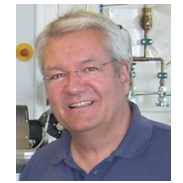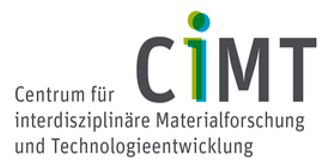-
Thin Films & Physics of Nanostructures
Prof. Dr. Andreas Hütten
© Universität Bielefeld
Research: Magnetic nanoparticles, biosensors and special alloys

Due to their special characteristics monodisperse magnetic nanoparticles are very interesting for technological applications like high density data storage and as magnetic markers in biological systems for detection and manipulation of attached molecules. Such particles prepared in collaboration with the group of Prof. Jutzi (inorganic chemistry) by a high-temperature solution phase synthesis, consist of a metallic core with diameters between 2- 15 nm and a stabilizing organic ligand shell. For the investigation of structure, composition and magnetic properties of the particles we use self-assembled particle monolayers on substrates. In the upper left corner an image of a superlattice of FeCo alloyed particles is shown.
The biosensor group is working on several different topics for the use of magnetic markers as labels for biomolecules or for characterization of biological systems. The main principle is to attach DNA or proteins to magnetic nanoparticles, which can then be detected by magnetoresistive sensors. This method can be used, e.g., to manipulate biomolecules on a chip (lab-on-a-chip) or to perform bond force measurements between different kinds of biological molecules.
To optimize the MTJs yielding high TMR ratio, we investigate new components as electrode and tunnel barrier materials. The 'classic' MTJ utilizes Aluminum-oxide as a tunnel barrier and 3d-ferromagnet (alloys) as electrode materials giving up to about 50% TMR ratio at room temperature. More recently, amorphous Co-Fe-B electrodes were introduced and higher ratios of up to 70% at room temperature were found. To increase these values even further, Heusler alloys and Fe3O4 are investigated. Theoretical calculations predict very a high spin-polarization at the Fermi-level for these compounds, which would lead to very high TMR ratios.
Please send general emails to Andreas Hütten (andreas.huetten@uni-bielefeld.de).
Bachelor- and Masterthesis
Research is moving on every day, please contact me directly via email (andreas.huetten@uni-bielefeld.de) to ask for the latest opportunities for bachelor's and master's theses.PhD and PostDoc positions
All open positions can be found here.
Vita
 Prof. Dr. Andreas Hütten is a professor of physics of nanostructures at Bielefeld University. Currently, his research
activities are focussed an magnetic nanoparticles, magnetoresistive biosensors and materials development
for magnetoelectronic devices.
Prof. Dr. Andreas Hütten is a professor of physics of nanostructures at Bielefeld University. Currently, his research
activities are focussed an magnetic nanoparticles, magnetoresistive biosensors and materials development
for magnetoelectronic devices.
Collaborative units
The research of the group is frequently done in collaborations with other scientists. At present, the group is cooperates within the following research centers:
CiMT

is funded by the EU (EFRE). The strategic goal of the CiMT is to combine the complementary strengths of the Bielefeld University of Applied Science and Bielefeld University for application-oriented materials research in partnership with technologically leading companies in the region for better products and production processes. Within the CiMT, the group explores protective coatings on metals and plastics.
